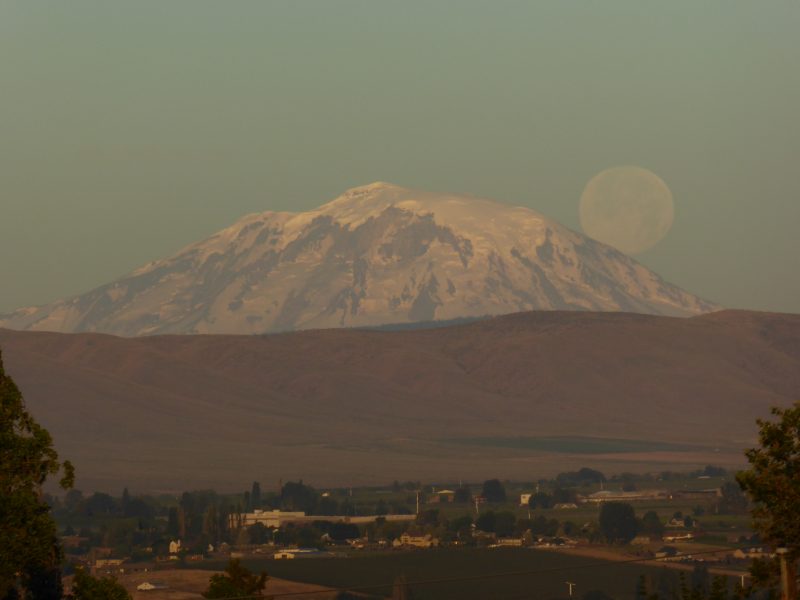

Jeff Hagan in Yakima, Washington wrote on July 10, 2017: “I woke up early and stepped onto the deck at our house in Yakima to check the weather. I was just in time to watch the full moon set over Mt. Adams, a 12,300-foot glaciated volcano in the Cascade Mountains. The moon appeared to be rolling down the north ridge of the mountain.”
This week – beginning Monday morning, June 30, 2018 – watch for the daytime moon. No matter where you are on Earth, look generally westward after sunrise to see the moon in a clear blue daytime sky.
Why can you see the moon in the daytime now? The full moon took place just a few days ago. That means the moon is now in a waning gibbous phase, rising after nightfall and setting in a westward direction after sunrise.
If you look for the moon at the same time every morning, you’ll see it appearing higher and higher in the western sky each early morning, all week long. To understand why, think about where the sun is in early morning. The moon is moving in its orbit around Earth, drawing closer and closer to the Earth-sun line.
By August 4, the moon will be at the last quarter phase – rising around midnight and southward around dawn. Then the moon will turn new on August 11, giving us deliciously dark skies for the upcoming Perseid meteor shower.

Jeff Hagan in Yakima, Washington wrote on July 10, 2017: “I woke up early and stepped onto the deck to check the weather. I was just in time to watch the full moon set over Mt. Adams, a 12,300-foot glaciated volcano in the Cascade Mountains. The moon appeared to be rolling down the north ridge of the mountain.”
People love to see the daytime moon. They wonder about it, and ask about it. Once, a reader in Kansas City wrote in with the name “children’s moon” to describe a moon visible during the day. She said this name stemmed from the idea that children can’t stay up at night late enough to see the moon when it appears only in darkness.
That story prompted another reader to send in an alternate version for the origin of the name children’s moon. She wrote:
I heard a daytime moon was called a ‘children’s moon’ because their eyes were sharp enough to pick it out, where the old folks, with fading vision, could not tell it from the clouds.
Can you see the daytime moon in the next few mornings?

Simulation of the moon’s phase for July 11, 2017 via the US Naval Observatory.
Bottom line: In the days after every full moon, the moon appears in the west after sunrise, in a blue sky. Watch for it.
Four keys to understanding moon phases
Total eclipse of sun: August 21, 2017
from EarthSky https://ift.tt/2t3Y7VJ


Jeff Hagan in Yakima, Washington wrote on July 10, 2017: “I woke up early and stepped onto the deck at our house in Yakima to check the weather. I was just in time to watch the full moon set over Mt. Adams, a 12,300-foot glaciated volcano in the Cascade Mountains. The moon appeared to be rolling down the north ridge of the mountain.”
This week – beginning Monday morning, June 30, 2018 – watch for the daytime moon. No matter where you are on Earth, look generally westward after sunrise to see the moon in a clear blue daytime sky.
Why can you see the moon in the daytime now? The full moon took place just a few days ago. That means the moon is now in a waning gibbous phase, rising after nightfall and setting in a westward direction after sunrise.
If you look for the moon at the same time every morning, you’ll see it appearing higher and higher in the western sky each early morning, all week long. To understand why, think about where the sun is in early morning. The moon is moving in its orbit around Earth, drawing closer and closer to the Earth-sun line.
By August 4, the moon will be at the last quarter phase – rising around midnight and southward around dawn. Then the moon will turn new on August 11, giving us deliciously dark skies for the upcoming Perseid meteor shower.

Jeff Hagan in Yakima, Washington wrote on July 10, 2017: “I woke up early and stepped onto the deck to check the weather. I was just in time to watch the full moon set over Mt. Adams, a 12,300-foot glaciated volcano in the Cascade Mountains. The moon appeared to be rolling down the north ridge of the mountain.”
People love to see the daytime moon. They wonder about it, and ask about it. Once, a reader in Kansas City wrote in with the name “children’s moon” to describe a moon visible during the day. She said this name stemmed from the idea that children can’t stay up at night late enough to see the moon when it appears only in darkness.
That story prompted another reader to send in an alternate version for the origin of the name children’s moon. She wrote:
I heard a daytime moon was called a ‘children’s moon’ because their eyes were sharp enough to pick it out, where the old folks, with fading vision, could not tell it from the clouds.
Can you see the daytime moon in the next few mornings?

Simulation of the moon’s phase for July 11, 2017 via the US Naval Observatory.
Bottom line: In the days after every full moon, the moon appears in the west after sunrise, in a blue sky. Watch for it.
Four keys to understanding moon phases
Total eclipse of sun: August 21, 2017
from EarthSky https://ift.tt/2t3Y7VJ

Aucun commentaire:
Enregistrer un commentaire